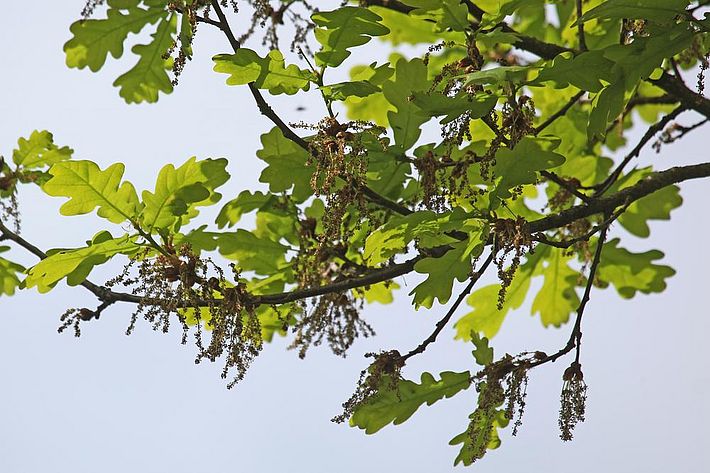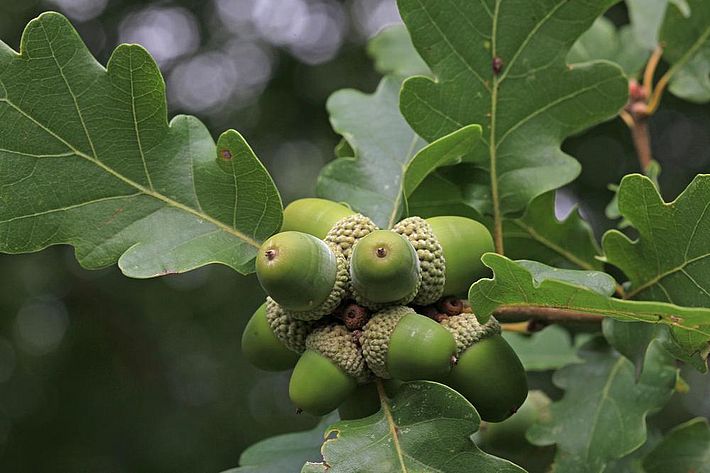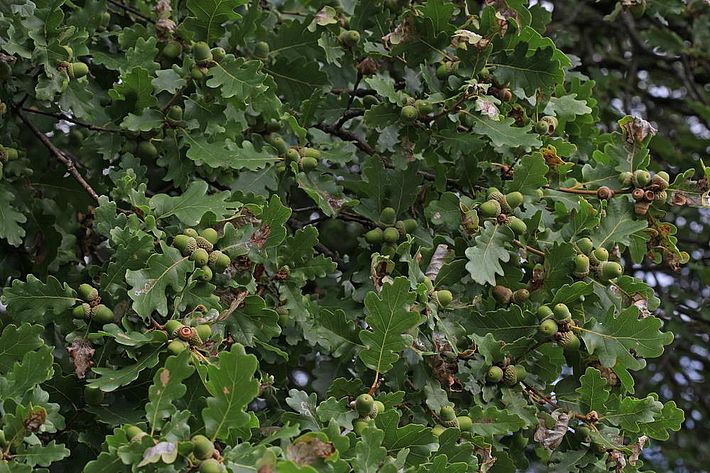Quercus petraea Liebl. | F: Chêne sessile | I: Quercia rovere | R: Ruver puschlà/tardiv | D: Traubeneiche ¶
General information on the sessile oak ¶
Sessile oak is more common in Switzerland than pedunculate oak, especially in Valais and Ticino1. It tolerates more drought than the pedunculate oak and is at the same time more susceptible to late frosts1.
Blooming ¶
As with all beech plants (Fagaceae), the flowers of the Sessile Oak are unisexual and the male flowers are in a pendulous spike, a so-called catkin (Fig. 1). The Sessile Oak flowers from late April to mid-June, about two weeks later than the pedunculate oak2. This minimises the risk of its flowers being damaged by late frosts2.
Fruits ¶
The acorns are surrounded by a woody fruit cupule, the so-called cupula. The fruits of the sessile oak are sessile and sit directly on the branches (Fig. 2). They are ripe in October and then fall to the ground. Acorns only remain germinable for a short time and do not form a seed bank.
Seed masting behaviour ¶
Oak mast occurs relatively frequently in our latitudes, namely every 2 to 3 years3. So far, it is unclear which factors trigger or prevent oak mast. Connections with climatic factors vary regionally3. In contrast to beech and spruce, pollen quantity does not seem to be an indicator of seed production4. Due to their high-calorie content5, acorns are an important food source for many wild animals, so that up to 40% of the fruits are eaten before they germinate6.
Assessment of seed mast ¶
Time: End of September. In sessile oak, it is difficult to distinguish between empty and filled fruit cups before seed ripening. Master surveys should therefore only be carried out shortly before seed drop.
Assessment of fruiting: Seed masting is a phenomenon that does not affect the individual tree, but encompasses entire stands in a larger geographical area. The intensity of an oak mast can be assessed according to the following key:

1 Brändli UB (1996) Die häufigsten Waldbäume der Schweiz. Ber. Eidg. Forsch.anst. Wald Schnee Landsch. 342
2 www.waldwissen.ch
3 Wohlgemuth T, Nussbaumer A, Burkart A, Bollmann K (2016) Eichenmast und Wildschweine. Zürcher Wald 3/16: 28-30
4 Kasprzyk I, Ortyl B, Dulska-Jeż A (2014) Relationships among weather parameters, airborne pollen and seed crops of Fagus and Quercus in Poland. Agricultural and Forest Meteorology 197: 111-122
5 Kallman S (1991) Nutritive value of Swedish wild plants. Svensk Botanisk Tidskrift 85: 397-411
6 Gurnell J (1993) Tree seed production and food conditions for rodents in an oak wood in southern England. Forestry 66: 291-315
Download ¶



